Creating InfoPackages to Load Characteristic Data
BW uses InfoPackages to define how to select data, and when to transfer and load the data. In BW, a characteristic can consist of three data components:
- Master data, or attributes as they are sometimes called
- Text
- Hierarchy
Section 7.1, "BW Star Schema," discusses master data, texts, and hierarchies and explains their relationships to characteristics.
Each part requires an InfoPackage. This section describes how to create InfoPackages to load master data and text. The next section covers entering master data and text manually.
Work Instructions
Step 1. Right-click Source System demo: flat file, and then select Create InfoPackage….
SCREEN 3.16
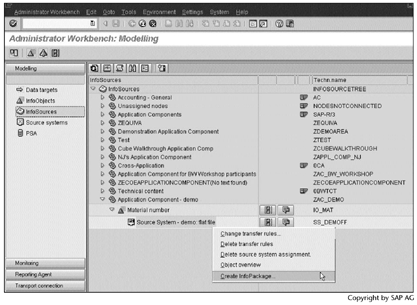
Step 2. Select the DataSource Material number (Master data), enter a description for the InfoPackage, and then click  to continue.
to continue.
SCREEN 3.17
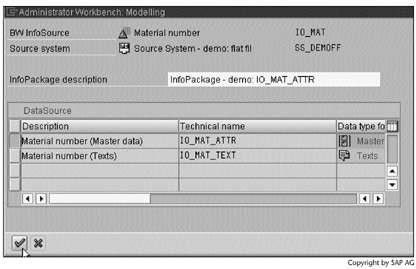
Step 3. Click the External data tab. Select options as shown in the screen. Enter a file name with a path. The file contains the data given in Table 3.1.
SCREEN 3.18
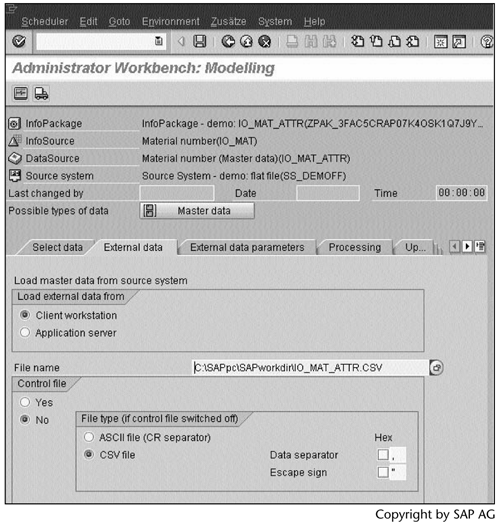
Note
The data file can reside on a front-end computer (or Client workstation as it is called here) or one of the application servers in the SAP Basis three-tier architecture. In our example, IO_MAT_ATTR.CSV resides in our front-end computer. For better loading performance, it is recommended that you place data files in application server computers.
Step 4. Click the Schedule tab, select the option Start data load immediately, and then click  to load data.
to load data.
SCREEN 3.19
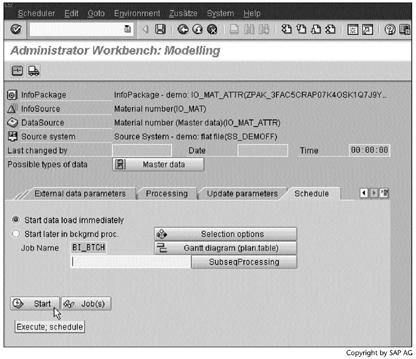
Result
The staging engine starts to load the data. A status message Data was requested will appear at the bottom of Screen 3.19.
Note
To schedule the loading operation for a later date or to execute loading periodically, select the option Start later in bckgrnd proc, and then click  . A pop-up window appears, as shown in Screen 3.20. You can set up a background process to start the data loading job based on the criteria specified in Screen 3.20. The same window is used in R/3 for background job scheduling. In essence, BW Scheduler is embedded in InfoPackages.
. A pop-up window appears, as shown in Screen 3.20. You can set up a background process to start the data loading job based on the criteria specified in Screen 3.20. The same window is used in R/3 for background job scheduling. In essence, BW Scheduler is embedded in InfoPackages.
SCREEN 3.20
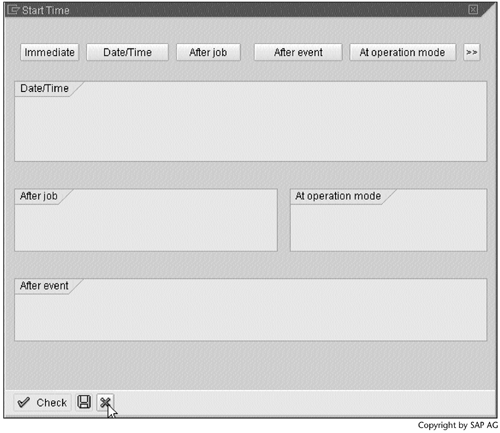
| MAT001 | TEA |
| MAT002 | COFFEE |
| MAT003 | COOKIE |
| MAT004 | DESK |
| MAT005 | TABLE |
| MAT006 | CHAIR |
| MAT007 | BENCH |
| MAT008 | PEN |
| MAT009 | PAPER |
| MAT010 | CORN |
| MAT011 | RICE |
| MAT012 | APPLE |
| MAT013 | GRAPEFRUIT |
| MAT014 | PEACH |
| MAT015 | ORANGE |
By repeating this procedure and selecting DataSource Material number (Texts) (Screen 3.21), we can load the texts in Table 3.2.
SCREEN 3.21
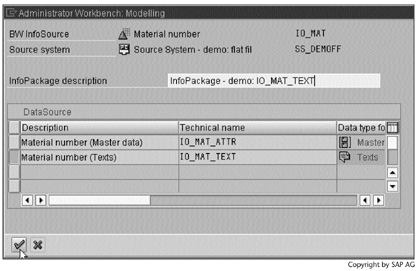
| E | MAT001 | Ice tea |
| E | MAT002 | Hot coffee |
| E | MAT003 | Fortune cookie |
| E | MAT004 | Computer desk |
| E | MAT005 | Dining table |
| E | MAT006 | Leather chair |
| E | MAT007 | Wood bench |
| E | MAT008 | Black pen |
| E | MAT009 | White paper |
| E | MAT010 | America corn |
| E | MAT011 | Asia rice |
| E | MAT012 | New York apple |
| E | MAT013 | Florida grapefruit |
| E | MAT014 | Washington peach |
| E | MAT015 | California orange |
The first column specifies the language of the texts, with "E" indicating English.
Part I. Guided Tours
Business Scenario and SAP BW
- Business Scenario and SAP BW
- Sales Analysis A Business Scenario
- Basic Concept of Data Warehousing
- BW An SAP Data Warehousing Solution
- Summary
Creating an InfoCube
- Creating an InfoCube
- Creating an InfoArea
- Creating InfoObject Catalogs
- Creating InfoObjects Characteristics
- Creating InfoObjects Key Figures
- Creating an InfoCube
- Summary
Loading Data into the InfoCube
- Loading Data into the InfoCube
- Creating a Source System
- Creating an Application Component
- Creating an InfoSource for Characteristic Data
- Creating InfoPackages to Load Characteristic Data
- Checking Loaded Characteristic Data
- Entering the Master Data, Text, and Hierarchy Manually
- Creating an InfoSource for Transaction Data
- Creating Update Rules for the InfoCube
- Create an InfoPackage to Load Transaction Data
- Summary
Checking Data Quality
- Checking Data Quality
- Checking InfoCube Contents
- Using BW Monitor
- Using the Persistent Staging Area (PSA)
- Summary
Creating Queries and Workbooks
- Creating Queries and Workbooks
- Creating a Query Using BEx Analyzer
- Organizing Workbooks Using BEx Browser
- Using a Variable to Access a Hierarchy Node Directly
- Summary
Managing User Authorization
- Managing User Authorization
- Creating an Authorization Profile Using Profile Generator
- Creating an Authorization Object to Control User Access to the InfoCube Data
- Integrating Profile Generator and BEx Browser
- Summary
Part II. Advanced Topics
InfoCube Design
- InfoCube Design
- BW Star Schema
- InfoCube Design Alternative I Time-Dependent Navigational Attributes
- InfoCube Design Alternative II-Dimension Characteristics
- InfoCube Design Alternative III Time-Dependent Entire Hierarchies
- Other InfoCube Design Techniques
- Summary
Aggregates and Multi-Cubes
Operational Data Store (ODS)
- Operational Data Store (ODS)
- Creating an ODS Object
- Preparing to Load Data into the ODS Object, Then into an InfoCube
- Loading Data into the ODS Object
- Loading Data into the InfoCube
- Using 0RECORDMODE for Delta Load
- Summary
Business Content
- Business Content
- Creating an R/3 Source System
- Transferring R/3 Global Settings
- Replicating R/3 DataSources
- Installing Business Content Objects and Loading R/3 Data
- Summary
Generic R/3 Data Extraction
- Generic R/3 Data Extraction
- Creating Views in R/3
- Creating DataSources in R/3 and Replicating Them to BW
- Creating a Characteristic in BW
- Loading Data from R/3 into BW
- Summary
Data Maintenance
Performance Tuning
- Performance Tuning
- BW Statistics
- System Administration Assistant
- Tuning Query Performance
- Tuning Load Performance
- Summary
Object Transport
Appendix A. BW Implementation Methodology
Object Transport
Appendix B. SAP Basis Overview
Object Transport
- Object Transport
- Section B.1. SAP Basis 3-Tier Architecture
- Section B.2. Dispatcher, Work Processes, and Services
- Section B.3. Memory Management
Appendix C. Glossary
Appendix D. Bibliography
EAN: N/A
Pages: 106
